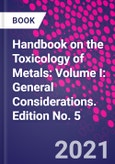Handbook on the Toxicology of Metals, Fifth Edition, Volume I: General Considerations is the first volume of a two-volume work that gives an overview and covers topics of general importance including reviews of various health effects of trace metals. The book emphasizes toxic effects in humans, along with discussions on the toxic effects of animals and biological systems in vitro when relevant. The book has been systematically updated with the latest studies and advances in technology and contains several new chapters. As a multidisciplinary resource that integrates both human and environmental toxicology, the book is a comprehensive and valuable reference for toxicologists, physicians, pharmacologists, and environmental scientists in the fields of environmental, occupational and public health.
Please Note: This is an On Demand product, delivery may take up to 11 working days after payment has been received.
Table of Contents
1. Toxicology of metals: Overview, definitions, concepts, and trends 2. General chemistry of metals, sampling, analytical methods, and speciation 3. Exposure, dose, and toxicokinetics of metals 4. Toxicity of metal and metal oxide nanoparticles 5. Toxicity of metals released from implanted medical devices 6. Metals and air pollution 7. Toxic metals in food 8. Interaction of toxic metals with the gut microbiome 9. Biological monitoring of metals and biomarkers 10. Computational modeling and dosimetry of metals 11. Selected molecular mechanisms of metal toxicity and carcinogenicity 12. Effects of metals on extracellular vesicle signaling 13. General considerations of dose-effect and dose-response relationships 14. Interactions and mixtures in metal toxicology 15. Gene-Environment interactions and metal toxicity 16. Epidemiological approaches to metal toxicology 17. Essential metals: assessing risks from deficiency and toxicity 18. The interaction of metals and the skin: the good, bad, and the ugly 19. Metals and the respiratory tract 20. Neurotoxicology of metals 21. Metals and cardiovascular disease 22. Renal effects of exposure to metals 23. Carcinogenicity of metal compounds 24. Immunotoxicology of metals 25. Effects of metallic elements on reproduction and development 26. Ecotoxicology of metals-sources, transport, and effects on the ecosystem 27. Risk assessment for metal exposures 28. Diagnosis and treatment of metal poisoning general aspects 29. Principles for prevention of the toxic effects of metals 30. Metal toxicology in low-income and lower-middle-income countries








